Brightness and Contrast Ratio
For those that need accurate colors, hardware color calibration is basically a given. Here, we report scores for the same areas as we did on the previous page, only this time the results are taken after we have used Monaco Optix XR Pro to calibrate the display.
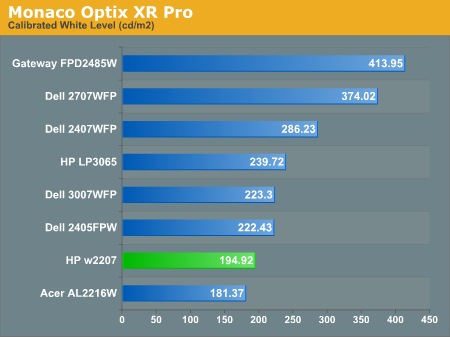
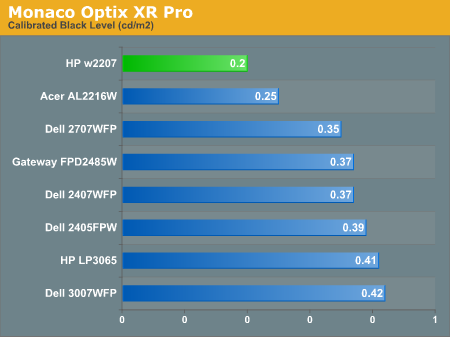
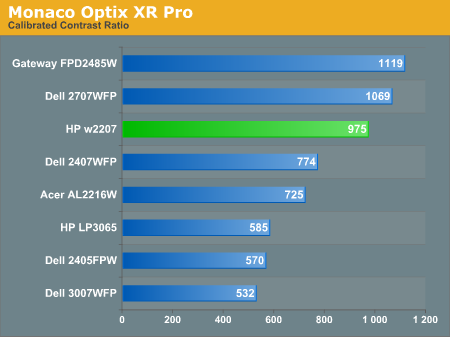
Calibration almost always results in the use of decreased brightness levels, and all of the displays end up running at less than their maximum brightness. You can of course choose to run a display at a higher than recommended brightness level, and the ambient lighting in a room will also determine what brightness setting is best. Our testing was performed indoors with a moderate amount of lighting, and the displays were adjusted according to directions. We also found that manually reducing the brightness level to something more reasonable (like 200-300 nits) did not significantly affect the results on any of these displays, so consider the above charts as more of a maximum recommended brightness for each particular LCD. The HP w2207 continues to generate very good contrast ratios, thanks to the very dark blacks it produces.
Color Accuracy
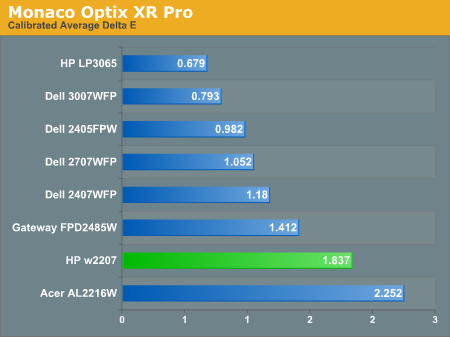
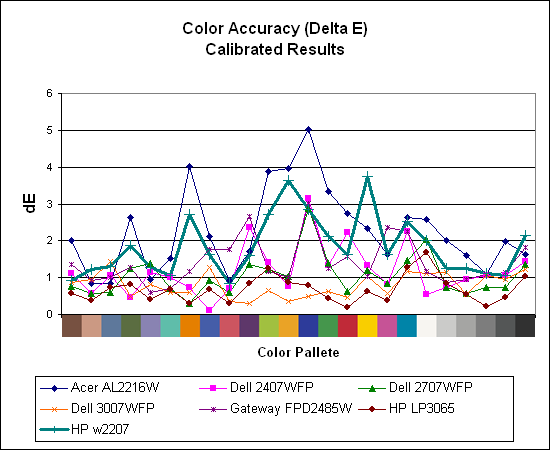
Calibration improves the color accuracy results significantly on all of the displays, although the HP w2207 remains in second to last place. Where the Acer was the best uncalibrated display, it becomes the worst scoring display after calibration. However, outside of professional image editing virtually any of the displays provide acceptable colors once calibrated.
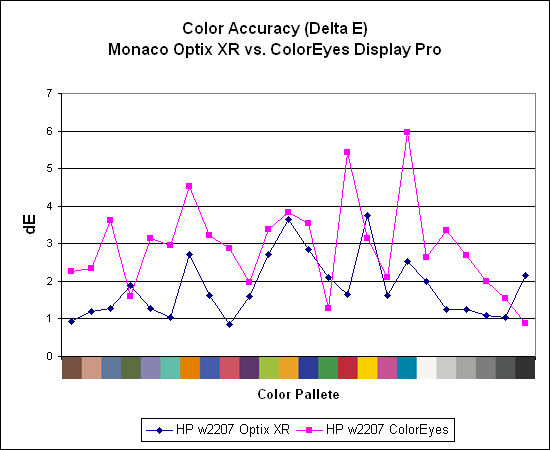
After discovering during our laptop display tests that certain displays appear to respond better to different calibration software, we decided to use ColorEyes Display Pro to test desktop LCDs as well. So far, we have yet to encounter a desktop LCD that scores better using ColorEyes Display Pro, which is actually surprising to us. Monaco Optix XR is an older software package that hasn't been updated since 2004, but it continues to work very well. Both packages also run under Windows Vista, though installation of the colorimeter drivers requires quite a bit more jumping through hoops and even after calibration we're still not entirely sure that Vista is using the color profiles properly. The testing and evaluation process works with the correct color profiles, but outside of the applications Vista seems to change color profiles at times.
For those that need accurate colors, hardware color calibration is basically a given. Here, we report scores for the same areas as we did on the previous page, only this time the results are taken after we have used Monaco Optix XR Pro to calibrate the display.



Calibration almost always results in the use of decreased brightness levels, and all of the displays end up running at less than their maximum brightness. You can of course choose to run a display at a higher than recommended brightness level, and the ambient lighting in a room will also determine what brightness setting is best. Our testing was performed indoors with a moderate amount of lighting, and the displays were adjusted according to directions. We also found that manually reducing the brightness level to something more reasonable (like 200-300 nits) did not significantly affect the results on any of these displays, so consider the above charts as more of a maximum recommended brightness for each particular LCD. The HP w2207 continues to generate very good contrast ratios, thanks to the very dark blacks it produces.
Color Accuracy


Calibration improves the color accuracy results significantly on all of the displays, although the HP w2207 remains in second to last place. Where the Acer was the best uncalibrated display, it becomes the worst scoring display after calibration. However, outside of professional image editing virtually any of the displays provide acceptable colors once calibrated.

After discovering during our laptop display tests that certain displays appear to respond better to different calibration software, we decided to use ColorEyes Display Pro to test desktop LCDs as well. So far, we have yet to encounter a desktop LCD that scores better using ColorEyes Display Pro, which is actually surprising to us. Monaco Optix XR is an older software package that hasn't been updated since 2004, but it continues to work very well. Both packages also run under Windows Vista, though installation of the colorimeter drivers requires quite a bit more jumping through hoops and even after calibration we're still not entirely sure that Vista is using the color profiles properly. The testing and evaluation process works with the correct color profiles, but outside of the applications Vista seems to change color profiles at times.










43 Comments
View All Comments
jc44 - Thursday, August 2, 2007 - link
Initially that would have been the approx asking price (medical applicatinos I think). They got cheaper as time went on though they were never exactly cheap. The Viewsonic (VP2290B) and Iiyama badged versions got under ~$7000 I think (which was approx twice the price on an Apple 30" at the time). Currently a DG5 (the last iteration) goes for ~$3500 on ebay and a VP2290B is ~$1000.The T221 was the first monitor that made me think "The best LCDs are btter than the best CRTs - now they only have to get cheap enough".
I was really hoping that they would take off and the price would come down to something like the current ebay prices. (And yes I did buy off ebay in the end)
Great Googly Moogly - Friday, August 3, 2007 - link
Aye, they're pretty damn cool. I've yet to see one in the flesh though. You still have to have 2 dual-link cards with it though? Doesn't it use 4 single-link connectors?And isn't the 48 Hz data rate (all 4 links) OK enough? (Yeah yeah, TFTs don't have refresh rates, I know, but there are other ramifications of a slow data rate.)
yacoub - Wednesday, August 1, 2007 - link
Not sure why 22" is starting to become prominent over 20". Must be cheaper to produce because tolerances and processes don't have to be as tight, since they're the same resolution just a larger (and thus more visible) pixel pitch on the 22" (0.282mm). Would rather stick with a 20", or if I want bigger then I'd get a 23-24" with 1920x resolution.Jedi2155 - Wednesday, August 1, 2007 - link
When comparing TN 20" versus a 22" panel with around $50 difference, i'd definitely go for the 22" mainly due to the larger screen space which makes games and movies more life-like.Sure the resolution hasn't changed, but why do people buy big screens with lower resolutions anyways? Just to get the bigger picture of course.
Oh, I also think there is a typo on Page 5 at the last paragraph.
You mentioned
But shouldn't it be
JarredWalton - Wednesday, August 1, 2007 - link
I corrected the Acer/Acer sentence -- HP seemed to be a bit better in the vertical plane. Things for the comment.nilepez - Wednesday, August 1, 2007 - link
I think the difference is that if you buy an 70" HDTV, you're not sitting as close as you are if you have a 42". Besides, a smaller TV with accurate colors trumps a big POS set with crap colors (and I've seen some awful HD monitors).
As a result, if the colors are better on the 20", I'd go with a 20".
JarredWalton - Wednesday, August 1, 2007 - link
I think a lot of the better 20" LCDs were IPS or PVA, which might account for the prices as well. Dell I'm pretty sure was IPS on the 2005FP (and FPW?). I think the cheaper 20" LCDs are now also using TN panels. Could be that they can only get the same amount of 22" or 20" panels out of a modern glass substrate, though... I haven't looked into it closely.Spoelie - Wednesday, August 1, 2007 - link
P-MVA and A-MVA are disregarded in the article, even though they are among the best 'overal' monitor technologies, for 20" at least. Second fastest response time, 8 bit color, best movie picture quality, homogeneous viewing angles. It's superior to PVA anyway.JarredWalton - Wednesday, August 1, 2007 - link
I thought MVA and PVA were similar and only certain patents created separate names. Guess not. :) I have never actually tested an MVA panel to my knowledge, and most high-end panels use IPS these days. The next tier uses PVA, and then the lower quality stuff uses TN. The one of the days, though, I will hopefully get the chance to test an MVA panel in person.mostlyprudent - Wednesday, August 1, 2007 - link
I have been using an HP LP series LCD which uses (at least when I bought it) an S-IPS panel. I could never go back to a TN or other panel with less acurate color display.